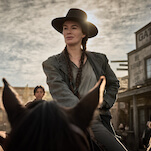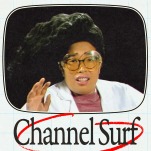1. Straight Out Of Brooklyn (1991)
It
sometimes takes a year or two to figure out whether filmmakers—or even
filmmaking trends—will become permanent part of the cinema landscape, or
if they're just cashing in on the way to obscurity. When Matty Rich's debut
film Straight Out Of Brooklyn took a Special Jury Prize at Sundance in 1991, the
half-million-dollar production was part of several waves: mini-budgeted films
paid for by credit cards and family donations, gritty urban films about
impoverished young people contemplating a life of crime, and heavily hyped
debuts by minority filmmakers. And while Straight Out Of Brooklyn made a respectable $2.7 million at
the box office and drew positive (if hardly ecstatic) reviews, most cineastes
and showbiz-followers in '91 likely expected more in the years to come than
what was ultimately delivered. Rich followed Straight Out Of Brooklyn with the justly forgotten
coming-of-age comedy The Inkwell, and has been silent ever since; meanwhile, the urban crime
genre quickly flamed out. What once looked vital now looks dated, and even a
little embarrassing.
2. In The Soup (1992)
In the year
that Reservoir Dogs, El Mariachi, and Gas Food Lodging all introduced new indie darlings to Sundance audiences,
the festival's Grand Jury Prize went to Alexandre Rockwell's second feature, an
inside-baseball comedy starring Steve Buscemi as a screenwriter who gets
involved with aging mobster Seymour Cassel in order to try to get his epic
script made into a movie. Rockwell later joined Quentin Tarantino, Robert
Rodriguez, and Alison Anders for the ill-fated anthology film Four Rooms, but as a director, Rockwell hit
his career peak in Park City. In The Soup barely scratched out $250,000 at the box office, and
his subsequent career has been a lot like the sad-sack life of the character
Buscemi played for him back in '92.
3. The Spitfire Grill (1996)
The
Sundance film festival helped nurture the American independent-film movement as
it blossomed in the early '90s, but by the middle of the decade, even the
fest's stewards were questioning whether it had lost its sense of purpose. The
reason? High-profile boondoggles like the record-breaking sale and subsequent
middling box office for The Spitfire Grill, a rustic melodrama that won the Audience Award in
1996 and sold to Castle Rock for $10 million, only to gross about $12
million in its theatrical release that fall. Though The Spitfire Grill was independent in origin and
financing—it was developed by a Catholic organization—its story of
a small-town redemption wasn't especially daring, edgy, or even sophisticated.
After a few more years of Sundance-bound indies aping the mainstream (albeit
with smaller budgets and more ragged edges), and a few more years of
independent film distributors manhandling or bypassing their old arthouse pals
in order to cut deals with bigger chains, all parties involved learned some
lessons about economies of scale.
4. The Myth Of Fingerprints (1997)
Anyone in
search of a blueprint for the popular-at-festivals/ignored-at-the-multiplex
indie drama should study Bart Freundlich's debut film The
Myth of Fingerprints,
a bland, predictable film built on the tense dinner conversations of placidly
uncomfortable upper-middle-class Northeasterners. Freundlich's
pseudo-sophisticated, presumably witty dialogue about sex, relationships, and
the pleasures of childhood wowed audiences at Sundance, but it barely eked out
a half-million dollars in box office in general release, probably because
people don't like to pay to see disconnected characters air their petty gripes
and then wander out of a precisely controlled frame, quickly forgotten.
5. Next
Stop Wonderland
(1998)
"I want to
be in the Brad Anderson business," Miramax honcho Harvey Weinstein declared
after dropping $6 million on this forgettable Boston-based romantic comedy.
Weinstein thought he would be adding another writer-director to a stable that
included Quentin Tarantino, Kevin Smith, and Jane Campion, but his investment
in "the Brad Anderson business" was limited to just this one feature. Had the
film not been the '98 festival's biggest success story, it might have overcome
its inflated reputation through a reasonably charming script and ace
performances by Hope Davis and Philip Seymour Hoffman. Davis, Hoffman, and
Anderson all moved on to better things; Weinstein, on the other hand, has
never stopped overspending.
6. Happy,
Texas (1999)
The
producers of this quirky nothing of a comedy turned out to be better
businessmen than filmmakers, prying open the wallets of suitors from every
studio boutique in the business. In the end, the biggest piranha, Miramax's
Harvey Weinstein, won the feeding frenzy for $10 million, but after the
buzzkill of extensive recutting and tepid reviews, Happy, Texas recouped just over a tenth of that
price. The film, about escaped cons posing as gay organizers of a beauty
pageant, seemed like a certain crossover hit at the time, but Miramax
discovered that there were sometimes limits to shameless commercial
calculation.
7. The Tao Of Steve (2000)
Sometimes a
movie falls betwixt and between. One year, audiences get excited by the slacker
philosophizing of Clerks; a decade later, they celebrate the arch Napoleon Dynamite. But in 2000? The Tao Of Steve won favor with Sundance crowds, who
awarded a special jury prize to star Donal Logue for his performance as an
easygoing dude with a quirky approach to romance. Yet when the movie entered
general release, both the character and the story seemed a little paltry, and The
Tao Of Steve failed
to become a permanent part of the pop-culture landscape. No one's selling Tao
Of Steve T-shirts,
that's for sure.
8. Raw Deal: A Question Of Consent (2001)
Though the
2001 festival would turn out such big-ticket items as Donnie Darko, In The Bedroom, and Memento, no film scored more
headlines—including a front-page New York Post story—than this exploitative
documentary about a possible rape caught on tape. Picked up for six figures by
the now-defunct Artisan Entertainment, the film got so tangled up in lawsuits
between the distributor and the filmmakers that it never saw a theatrical release,
which probably would have resulted in a fresh round of lawsuits anyway. Those
unfortunate few who saw the film got to witness graphic home-video footage of a
27-year-old stripper getting raped (or not) at a Delta Chi frat party, all
framed with the sensitivity and class of an Inside Edition segment.
9. Tadpole (2002)
With this
terminally slight coming-of-age story, shot on video in 14 days,
writer-director Gary Winick helped launch his erstwhile InDigEnt label, a DIY
experiment that was essentially an American answer to Denmark's Dogme 95. All
hail the digital revolution—exactly like the films you're used to seeing,
only much shittier-looking! InDigEnt later put its stamp on many other
unwatchable independent films—Pieces Of April, anyone?—but none got as much
unwarranted attention at the festival. For the $5 million purchase price, there
weren't enough cigars in Cuba for the spendthrifts at Miramax to light up with
their wasted bills.
10. Hounddog (2006)
Sight
unseen, writer-director Deborah Kampmeier's overripe Southern gothic was easily
the most talked-about film going into the 2006 festival, thanks to the
trumped-up controversy over a Dakota Fanning rape scene. Then people elbowed
their way into the first press screening and the film was never heard from
again. Ironically, few critics took issue with the rape, which Kampmeier
handled mostly through an effective use of offscreen space; it's the movie
itself that turned them off and reportedly evoked gales of unintended laughter.
Currently, Hounddog remains undistributed. Any takers?








































